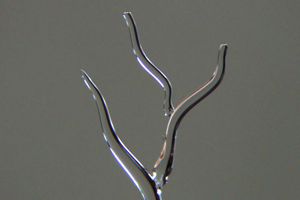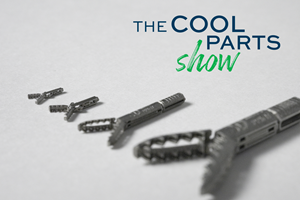Top 10 Stories of 2017
Popular topics include advances in metal 3D printing, medical applications and the auxiliary activities that support additive manufacturing.
Each December, the staff of Additive Manufacturing assembles a list of the top 10 most-viewed stories from the past year. This list offers a chance to look back not just on the most popular articles we published, but also on the things that current and future AM users were thinking about over the previous year.
2017 marks the year that this publication began to draw a conscious distinction between “3D printing” (the collective technologies that enable AM) and “additive manufacturing” (the overall manufacturing process that includes 3D printing, plus the business activities and auxiliary steps that support it). Read more about this distinction in the 6th story.
The difference between these two terms is also illustrated throughout the list. There is no lack of 3D-printing stories that cover specific technologies and their application. But there are also a number of stories concerned with material optimization, postprocessing and business considerations—all parts of that additive manufacturing ecosystem not directly related to 3D printing itself.
- GE Team Secretly Printed a Helicopter Engine, Replacing 900 Parts with 16
GE Additive’s Ehteshami says, “To make these parts the ordinary way, you typically need 10 to 15 suppliers, you have tolerances, you have nuts, bolts, welds and braces.” With additive, “all of that went away.” The helicopter project is a detail in a story worth knowing.
- 3D Printing with Postprocessing in Mind
3D printing requires different finishing considerations than traditional manufacturing. One expert offers do’s and don’ts for approaching the finishing of additively manufactured parts.
- Optimizing Metal Powders for Additive Manufacturing
What makes a good metal powder for additive manufacturing? Case study data highlights the value of particle size and shape, powder flowability, and bulk density.
- MarkForged Metal Printer: Sintering Can Wait
Separating 3D printing from high-temperature processing is part of how the company’s Metal X realizes a price less than established metal AM equipment.
- 3D Printing a Metal Shift Knob for Faster Cooling
Metal 3D printing and design thinking enabled an engineer to create a shift knob designed to cool rapidly inside a hot car.
- Additive Manufacturing and 3D Printing Are Two Different Things
And as AM continues to advance, the differences are becoming more pronounced and more important.
- Building an Additive Manufacturing Business for Production
What does it look like to build a business based on AM production from the ground up? An Ohio medical device contractor is finding out.
- Dissolvable Support Structures for Metal? Researchers Validate This Possibility
A 3D-printed stainless steel part was built using a support structure made of a different metal. No mechanical removal of the support structure was needed. The support was entirely dissolved away, eliminating an often-difficult manual step.
- 3D-Printed Medical Drills Keep Bone Cool During Surgery
Drills made via additive manufacturing cut bones without causing thermal-induced damage thanks to internal cooling channels.
- Video: Additive Manufacturing Advances at Caterpillar
Stacey DelVecchio of Caterpillar describes how AM is moving forward within a large and established company. Today, there is tooling and aftermarket parts. Ultimately, the technology will empower engineers to realize parts and products “they never even dreamed possible.”
For more stories like this in 2018, subscribe to the Additive Manufacturing magazine or e-newsletter. You can also follow us on Twitter, Facebook and LinkedIn.
Related Content
Ice 3D Printing of Sacrificial Structures as Small as Blood Vessels
Using water for sacrificial tooling, Carnegie Mellon researchers have created a microscale method for 3D printing intricate structures small enough to create vasculature in artificial tissue. The biomedical research potentially has implications for other microscale and microfluidics applications.
Read MoreMicro Robot Gripper 3D Printed All at Once, No Assembly Required: The Cool Parts Show #59
Fine control over laser powder bed fusion achieves precise spacing between adjoining moving surfaces. The Cool Parts Show looks at micro 3D printing of metal for moving components made in one piece.
Read MoreUnderstanding PEKK and PEEK for 3D Printing: The Cool Parts Show Bonus
Both materials offer properties desirable for medical implants, among other applications. In this bonus episode, hear more from Oxford Performance Materials and Curiteva about how these companies are applying PEKK and PEEK, respectively.
Read More3D Printed PEEK Spine Implants in Production: The Cool Parts Show Bonus
Curiteva is using Fused Strand Deposition to produce two different lines of FDA-cleared spine implants. We visited the company’s Huntsville, Alabama, facility to learn more.
Read MoreRead Next
3D Printed Polymer EOAT Increases Safety of Cobots
Contract manufacturer Anubis 3D applies polymer 3D printing processes to manufacture cobot tooling that is lightweight, smooth and safer for human interaction.
Read MoreProfilometry-Based Indentation Plastometry (PIP) as an Alternative to Standard Tensile Testing
UK-based Plastometrex offers a benchtop testing device utilizing PIP to quickly and easily analyze the yield strength, tensile strength and uniform elongation of samples and even printed parts. The solution is particularly useful for additive manufacturing.
Read MoreBike Manufacturer Uses Additive Manufacturing to Create Lighter, More Complex, Customized Parts
Titanium bike frame manufacturer Hanglun Technology mixes precision casting with 3D printing to create bikes that offer increased speed and reduced turbulence during long-distance rides, offering a smoother, faster and more efficient cycling experience.
Read More
.jpg;width=70;height=70;mode=crop)

















